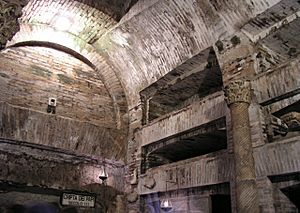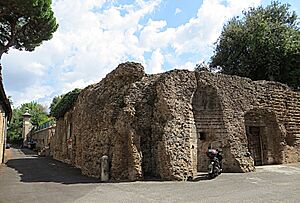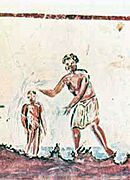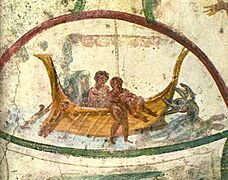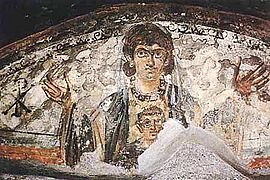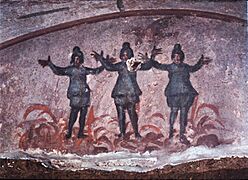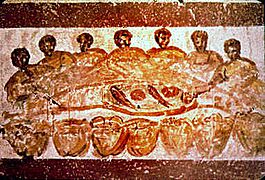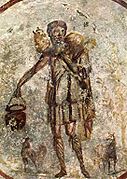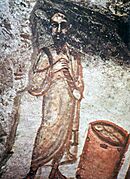Catacombs of Rome facts for kids
The Catacombs of Rome (Italian: Catacombe di Roma) are ancient underground burial places found in and around Rome. There are at least forty of these hidden tunnels, and some have only been found again recently.

While most famous for Christian burials, the catacombs were also used by Jews and followers of various ancient Roman religions. People started burying their dead here in the 2nd century AD. This was because ancient Roman law did not allow burials inside the city. The catacombs also helped with overcrowding and a lack of land. The largest and most well-known is the Christian Catacomb of Callixtus, located near the Park of the Caffarella. Other sites, both Christian and non-Christian, are spread around the city, some now covered by modern buildings.
The Christian catacombs are very important for understanding the history of Early Christian art. They contain most of the art from before 400 AD, including fresco paintings and sculpture. Jewish catacombs are also important for studying Jewish culture from this early time.
Contents
- What Does "Catacomb" Mean?
- Why Were Catacombs Built?
- What Did We Learn From Discoveries?
- Christian Catacombs
- How Were the Tunnels First Made?
- Decline and Rediscovery
- Catacombs Today
- How Roman Catacombs Are Built
- Famous Catacombs in Rome
- Catacombs of Marcellinus and Peter
- Catacombs of Domitilla
- Catacombs of Commodilla
- Catacombs of Generosa
- Catacombs of Praetextatus
- Catacombs of Priscilla
- Catacombs of San Callisto
- Catacombs of San Lorenzo
- Catacombs of San Pancrazio
- Catacombs of San Sebastiano
- Catacombs of San Valentino
- Catacombs of Sant'Agnese
- Catacombs of Via Anapo
- Jewish Catacombs
- Gallery of Paintings from the Catacombs of Rome
- See Also
What Does "Catacomb" Mean?
The word catacombs comes from the Latin word catatumbas. This word can mean "among the tombs" or "next to the quarry." The idea of "next to the quarry" comes from the first digging done to create these underground systems. These early excavations happened outside Rome, near a stone quarry.
Why Were Catacombs Built?

The Etruscan civilization lived in the area around Rome from about 900 to 100 BC. Like many other European groups, they buried their dead in underground chambers.
The original Roman custom was to cremate (burn) bodies. The ashes were then kept in pots or urns, often placed in a columbarium, which was like a building with many small niches.
By the 2nd century AD, Rome faced two big problems: too many people and not enough land. The city was growing, and many buildings were very tall. Also, burials were not allowed inside the city walls. Early Christians did not like the pagan practice of cremation because they believed in the resurrection of the body. So, shared underground cemeteries became a good solution.
From about the 2nd century AD, burying unburnt bodies became more common. This happened either in simple graves or, for richer people, in sarcophagi (stone coffins) that were often beautifully carved. By the 4th century, burial was more common than cremation. Jews and Christians preferred burial because they believed in preserving the body for the resurrection.
Building tombs above ground along roads, like the Via Appia, was very expensive. Digging out catacombs underground was much cheaper.
Even though many people think so, these tunnels were probably not used for regular church services at first. They were mainly for burial. However, people did hold memorial services and celebrations for Christian martyrs (people who died for their faith) there. There are sixty known underground burial chambers in Rome. They were built outside the city walls along major Roman roads, such as the Via Appia, the Via Ostiense, and the Via Nomentana. Some catacombs, like St Calixtus and St Sebastian, are named after martyrs who might have been buried there.
What Did We Learn From Discoveries?
Research has shown that people living in ancient Rome ate freshwater fish. Studies of a two-year-old child's remains showed that children were breastfed and this child had not yet stopped drinking milk from its mother.
Fish was important in Roman society for both everyday life and religion. It was a common food. For Christians, fish was also a symbol in their art and was eaten at meals held to remember the dead.
Christian Catacombs
Roman law did not allow burials inside city limits. So, all burial places, including the catacombs, were located outside the city walls. The first large catacombs near Rome were dug starting in the 2nd century. They were carved into "tufa" (tuff), a type of volcanic rock that is soft to dig but then hardens.
Christian catacombs served as burial grounds for early Christians. They contain old writings and early wall art. While catacombs were first used by Jews in the first century, by the end of the sixth century, there were over 60 Christian catacombs. The art in these catacombs shows how Christians in the first few centuries saw the world and their hopes for how it should be.
Some people used to think that Christians used the catacombs as secret hiding places during times of persecution by the Roman Empire. They believed Christians held their worship services there in secret.
However, many experts now say this is a myth. Christians were not persecuted all the time by the Roman Empire. Also, the larger rooms in the catacombs were not used for regular church services or gatherings. Instead, these rooms were used by Christians to "hold meals for the dead." This practice of "funerary meals" was common among most families in Rome, including non-Christians. So, Christians went into the catacombs to have memorial meals with their dead family members, just like their non-Christian neighbors. When persecutions happened, the locations of the catacombs were widely known, so they wouldn't have been good hiding places.
Christian art in the catacombs can be looked at in three ways: what it shows (iconographic), its style, and the techniques used. From the first to the sixth century, the art in Roman Christian catacombs went through different stages: an early phase, an Old Testament phase, and a New Testament phase.
Workers called excavators (or fossors) built huge systems of tunnels and passages, one on top of another. They are about 7 to 19 meters (23 to 62 feet) below the surface and cover more than 2.4 square kilometers (593 acres). Narrow steps connect the levels, going down as many as four stories. Passages are about 2.5 meters (8.2 feet) high and 1 meter (3.3 feet) wide.
Burial niches (loculi) were carved into the walls. They are 40 to 60 centimeters (16 to 24 inches) high and 120 to 150 centimeters (47 to 59 inches) long. Bodies were placed in these niches, often wrapped in linen. The niche was then sealed with a stone slab that had the person's name, age, and death date. The fresco paintings are the main surviving examples of Early Christian art. They often show typical Roman styles used in homes, but with religious meanings. Some families could build cubicula, which were small rooms for several family burials, often decorated. Another good place for art was the arcosolia, which were curved niches with a horizontal slab.
How Were the Tunnels First Made?
The complex system of tunnels that became the catacombs was first dug by the Etruscan people, who lived in the region before the Romans. These tunnels were initially created for mining various rock resources like limestone and sandstone. These quarries later became the base for more digging, first by the Romans for rock, and then by Christians and Jews for burial sites and mass graves.
Decline and Rediscovery
In 380 AD, Christianity became a state religion. At first, many people still wanted to be buried near martyrs in the catacombs. However, the practice of catacomb burial slowly decreased, and people were increasingly buried in church cemeteries above ground. After the Edict of Milan in 313 AD, many Roman Christians went to the catacombs to find relics (remains) of martyrs. This led to a lot of damage and stealing in the catacombs.
By the 6th century, catacombs were mainly used for memorial services for martyrs. Some new paintings were added as late as the 7th century. Invaders like the Ostrogoths, Vandals, and Lombards who attacked Rome also damaged the catacombs, likely looking for valuable items. By the 10th century, the catacombs were mostly abandoned, and holy relics were moved to churches above ground. Some historians suggest the catacombs fell into disrepair because of less religious activity in Rome after the Avignon Papacy, when the Pope moved away from Rome for a period.
For centuries, the catacombs were forgotten until they were accidentally found again in 1578. After this, Antonio Bosio spent decades exploring and researching them for his book Roma Sotterranea (1632). Later, archaeologist Giovanni Battista de Rossi (1822–1894) published the first detailed professional studies about the catacombs. In the 1950s, Italian authorities found more catacombs near Rome. Today, the catacombs are an important historical site for the early Christian church.
Catacombs Today
The Holy See (the government of the Catholic Church) is in charge of the Christian catacombs. They have special groups for this, like the Pontifical Commission of Sacred Archaeology, which manages digging and restoration. The Pontifical Academy of Archaeology studies the catacombs. Local priests or religious groups often manage the sites day-to-day. For example, the Salesian Fathers supervise the Catacombs of St. Callixtus.
Today, you can often find information online about visiting the catacombs, including addresses, opening hours, fees, and tour guides. Like other historical sites in Italy, catacombs might not be open at certain times or days, and you might need to book tickets online in advance. Currently, only 5 catacombs are open to the public: San Sebastiano, San Callisto, Priscilla, Domitilla, and Sant'Agnese.
How Roman Catacombs Are Built
Roman catacombs are made of underground passages called ambulacra. In the walls of these passages, horizontal niches called loculi were dug. These loculi were usually stacked one above another and could hold one or more bodies. When bodies were placed in loculi, they were often covered in a cloth and sometimes lime, which helped with the smell of decay. To make more money, workers would sometimes sell loculi that were already occupied to other people. A loculus big enough for two bodies was called a bisomus.
Another common type of burial in Roman catacombs was the arcosolium. This was a curved niche, closed off by a carved horizontal marble slab. Cubicula (burial rooms for one family, containing several loculi) and cryptae (chapels decorated with frescoes) are also often found in catacomb passages. When space became limited, other graves were dug into the floor of the corridors. These floor graves are called formae.
Famous Catacombs in Rome
There are forty Roman catacombs in the suburbs or former suburbs of Rome. They were built along the main roads leading out of the city, such as the Via Appia, the Via Ostiensis, the Via Labicana, the Via Tiburtina, and the Via Nomentana.
Catacombs of Marcellinus and Peter
These catacombs are on the ancient Via Labicana, now called Via Casilina, in Rome, Italy. They are near the church of Santi Marcellino e Pietro ad Duas Lauros. Their name comes from the Christian martyrs Marcellinus and Peter, who are traditionally believed to be buried here.
Catacombs of Domitilla
Close to the Catacombs of San Callisto are the large and impressive Catacombs of Domitilla, named after Saint Domitilla. They spread over 17 kilometers (10.5 miles) of tunnels. Since 2009, the Divine Word Missionaries, a Catholic group, have been in charge of managing these catacombs.
Catacombs of Commodilla
These catacombs, on the Via Ostiensis, have one of the earliest images of a bearded Christ. They originally held the remains of Saints Felix and Adauctus.
Catacombs of Generosa
Located on the Campana Road, these catacombs are believed to have been the temporary resting place for Simplicius, Faustinus and Beatrix, Christian Martyrs who died in Rome around 302 or 303 AD during a persecution.
Catacombs of Praetextatus
These catacombs are found along the Via Appia and were built in the late 2nd century. They are a large underground burial area, used first by pagans and then by Christians. They contain tombs of various Christian martyrs. In the oldest parts, you can find the "cubiculum of the coronation," which has a rare painting of Christ being crowned with thorns. There's also a 4th-century painting of Susanna and the old men, shown as a lamb and wolves.
Catacombs of Priscilla
The Catacomb of Priscilla, located on the Via Salaria, probably gets its name from the landowner whose property it was built on. The Benedictine nuns of Priscilla now look after them.
Catacombs of San Callisto
Located along the Appian Way, these catacombs were built after 150 AD. They include private Christian burial chambers and a burial area directly managed by the Catholic Church. It is named after the deacon Saint Callixtus, who was put in charge of this cemetery by Pope Zephyrinus. When Callixtus became pope, he made the complex larger, and it soon became the official cemetery for the Roman Church. The tunnels, where more than fifty martyrs and sixteen popes were buried, are part of a cemetery that covers fifteen hectares (37 acres). The Catacombs of San Callisto are about 90 acres in size, 12 miles long, and have 4 levels, going down more than 20 meters (65 feet) underground. Because so many popes are buried here, it has sometimes been called the "Little Vatican."
Catacombs of San Lorenzo
Built into the hill next to San Lorenzo fuori le Mura, these catacombs are said to be the final resting place of St. Lawrence. The church above was built by Pope Sixtus III and later changed into its current form. Sixtus also redecorated the shrine in the catacomb and was buried there.
Catacombs of San Pancrazio
These catacombs are underneath the San Pacrazio basilica, which was built by Pope Symmachus where the body of the young martyr Saint Pancras was buried. In the 17th century, the church and catacombs were given to the Discalced Carmelites, who completely changed them. The catacombs contain pieces of sculpture and old pagan and early Christian writings.
Catacombs of San Sebastiano
This is one of the smallest Christian cemeteries and has always been one of the easiest catacombs to reach. Because of this, it is also one of the least preserved. You can still see parts of the old church and collected sarcophagi (stone coffins) from the 4th century. This is where the martyrs Sebastian and Eutychius were buried.
Going down a staircase, you find tunnels with various cubicula (small burial rooms), including the cubiculum of Jonah with its beautiful paintings from the late 4th century. Then you reach the restored crypt of S. Sebastiano, with an altar and a statue of Saint Sebastian thought to be by Bernini. From here, you reach a platform. Below it is a sandstone area called ad catacumbas, which may have given this and all other similar tombs their name.
Three mausolea (tombs) from the second half of the 2nd century open off the platform. The first one on the right has paintings of funeral meals and a miracle. Inside, it has paintings (including a Gorgon's head on the ceiling) and burials. The second, sometimes called the "tomb of the Innocentiores," has a detailed stucco ceiling and a writing with the initials of the Greek words for "Jesus Christ, Son of God, Saviour." On the left is the mausoleum of Ascia, with a painting of grapevines growing up pillars.
A room called the "Triglia" rises from the platform. This covered room was used for funeral banquets. Its walls have hundreds of writings from people who attended these banquets, asking for help from the apostles Peter and Paul. From the "Trigilia," you could go into an old walkway that turns into a curved end. Here, there is a collection of tomb writings and a model of the mausolea. From here, you go down into the "Platonica," a building at the back of the church. It was once thought to be the temporary resting place for Peter and Paul, but excavations showed it was a tomb for the martyr Quirinus, whose remains were brought here in the 5th century.
Catacombs of San Valentino
These catacombs were dedicated to Saint Valentine. In the 13th century, the martyr's remains were moved to the Basilica of Saint Praxedes.
Catacombs of Sant'Agnese
Built to preserve and honor the remains of Saint Agnes of Rome. Agnes' bones are now kept in the church of Sant'Agnese fuori le mura in Rome, which was built over the catacomb. Her skull is in a side chapel in the church of Sant'Agnese in Agone in Rome's Piazza Navona.
Catacombs of Via Anapo
On the Via Salaria, the Catacombs of Via Anapo date to the late 3rd or early 4th century. They contain various paintings of stories from the Bible.
Jewish Catacombs
There are six known Jewish catacombs in Rome. Two of them are open to the public: Vigna Randanini and Villa Torlonia.
The Jewish catacombs were found in 1918, and archaeological excavations continued for twelve years. The structure has two entrances. The catacombs cover more than 13,000 square meters (140,000 sq ft) and date from the 2nd and 3rd centuries, possibly used until the 5th century. There are almost a hundred tomb inscriptions, but they don't show any special beliefs, except for some rare paintings with classic Jewish religious symbols. Jewish Catacombs are different from Christian ones in their symbols. Also, Jewish people did not visit the dead in the Catacombs. Parts of the Old Testament and the symbol of a candlestick with seven-branches have been seen on the walls of Jewish Catacombs.
Due to high humidity and temperature, the bones found in the catacombs have not been well preserved. Scientists often cannot tell the sex of the dead because of this poor preservation.
The other Jewish catacombs are not open to the public because their structure is unstable, and there is a gas called radon present.
Gallery of Paintings from the Catacombs of Rome
The Catacombs of Rome contain many different artworks. Most are religious, showing important Christian practices like baptism, or scenes and stories such as "The Three Hebrews and the Fiery Furnace," or biblical figures like Adam and Eve.
See Also
- Antonio Bosio, an Italian scholar who was the first to systematically explore underground Rome.
- Catacomb saints, bodies from the Roman catacombs that were decorated and presented as holy relics.
- Depictions of Jesus
- List of ancient monuments in Rome





